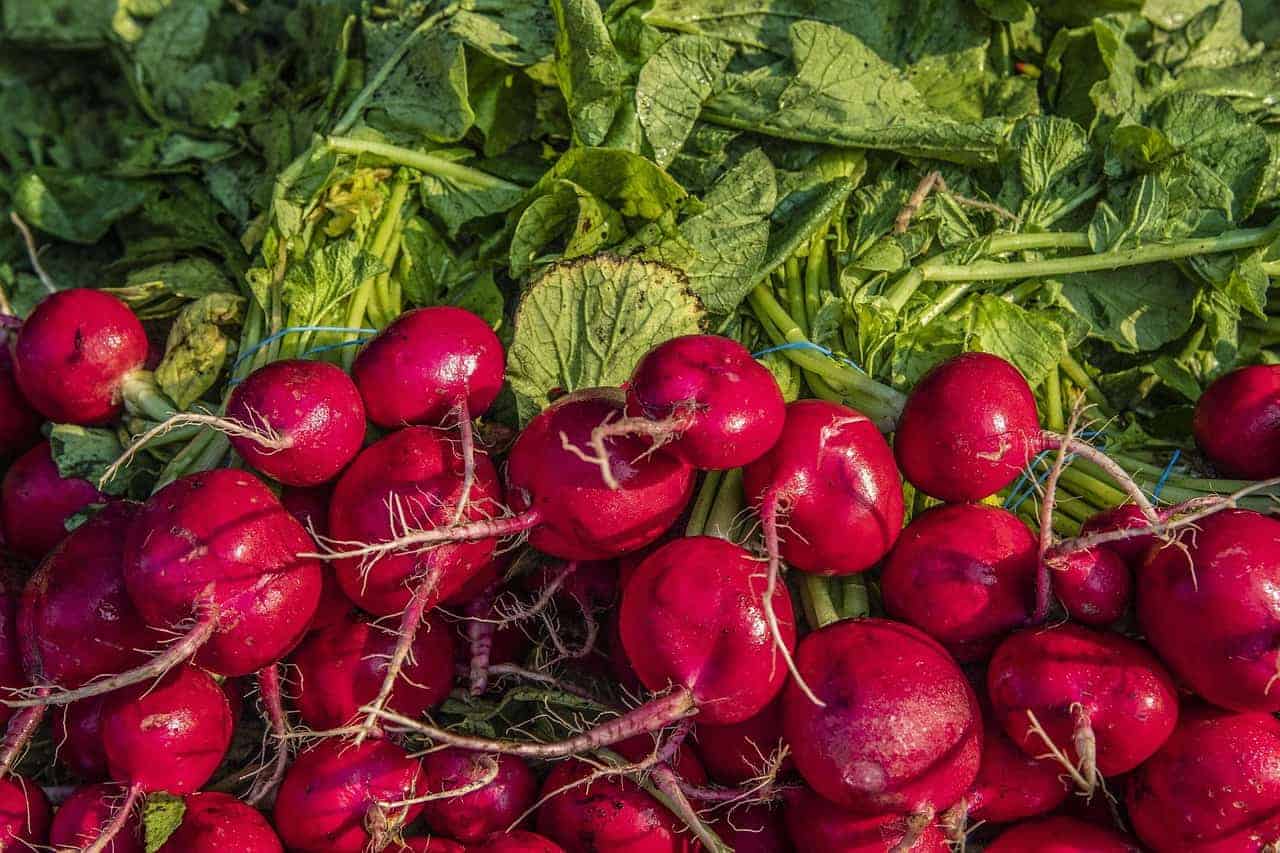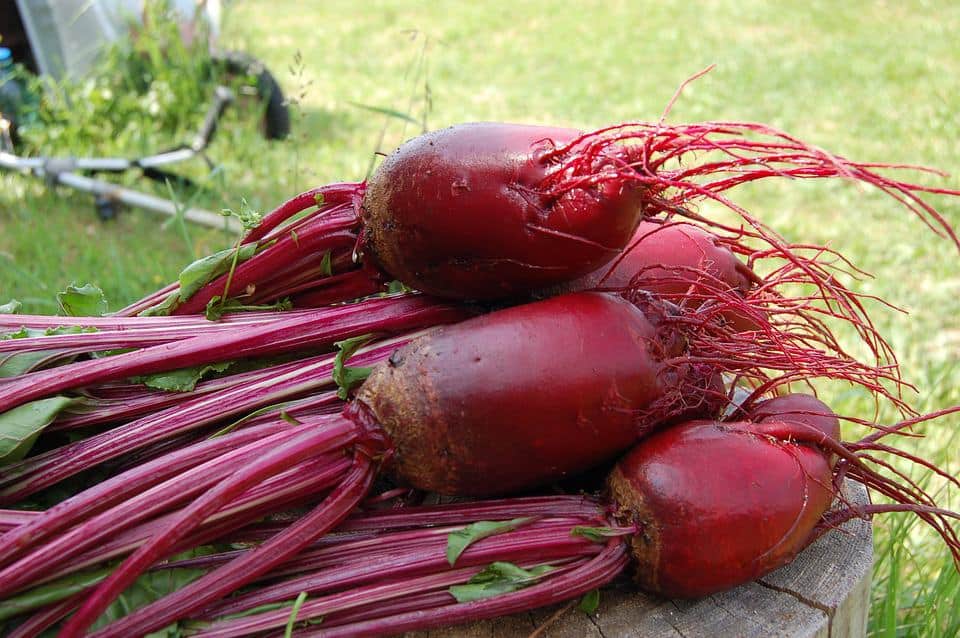The very first time I tried growing beets, they came out less than 1 inch in diameter, and this was after over 3 months of growth. Looking back, I know where I made my mistakes, and I’ve also researched more about what beets need to grow into large, sweet, red tubers. It’s a bit complicated, but there are several reasons why your beets seem to be stuck in adolescence.
On this page:
Why Do My Beets Grow Small?
There are many factors that affect the size and shape of your beets. I’m assuming you’re growing a normal-sized beet variety (there are some true “baby beet” varieties), and you’ve already waited until after the “days to maturity” on your seed packet to allow your beets enough time to grow and mature.
 First, consider how much sun your beets are getting. Beets are a cool weather crop, but really do best in full sun. Beets tolerate partial shade, but will mature more slowly. If they’re getting less than five hours of full sun per day, expect even slower growth. In this situation, there isn’t much you can do, but you can wait a few weeks after their days to maturity is up and see if they’re still growing (you can gently brush off the top layer of soil to get a better look at your beets). One of the advantages of growing beets in containers is that you can easily move your beets to a sunnier location.
First, consider how much sun your beets are getting. Beets are a cool weather crop, but really do best in full sun. Beets tolerate partial shade, but will mature more slowly. If they’re getting less than five hours of full sun per day, expect even slower growth. In this situation, there isn’t much you can do, but you can wait a few weeks after their days to maturity is up and see if they’re still growing (you can gently brush off the top layer of soil to get a better look at your beets). One of the advantages of growing beets in containers is that you can easily move your beets to a sunnier location.
Maybe your beets are already getting plenty of sun. What now? The two most common reasons for small beets are overcrowding and a lack or imbalance of soil nutrients. Beets need enough space to form a large, round bulb. If you plant your beets too close, they will grow into each other, compacting the soil between them and causing them to be constrained, stunting growth.
Ideally, you want single beets spaced at least 4 inches apart. Don’t forget that each “seed” is actually a dried package of several seeds, so thin out your beets after they’ve sprouted.
Lately, I’ve been trying Charles Dowding’s approach of multisowing beets and transplanting them. I talk about it more in my article on planting beets in containers but briefly, it means you sow multiple seeds in one hole, started indoors or directly sown, and then you thin to around 3-4 beet plants in each spot. It seems like they’d be overcrowded, but they actually end up pushing each other away and you end up with a clump of full-sized beets. Note that you will have to space out each clump of beets a little more, at least 5-8 inches between each clump of 3-4 beets.
The amount and ratio of nutrients in your soil can also impact the size of your beets. Do you have beautiful, lush beet plants loaded with healthy leaves, but down at the soil is just a tiny runt of a beet? You might have too much nitrogen in your soil, which promotes leaf and stem growth, or you might not have enough phosphorus, which is important for root development. If this is the case for you, the good news is that beet leaves are edible and very tender and delicious.
 Other things to consider are how compacted your soil is (beets prefer fluffy, light soil) and if you damaged the roots during transplanting. Most people are advised to directly sow beets, but I have transplanted them with success; just make sure to be gentle when transplanting and don’t let the seedlings get too large before doing it (2 to 4 sets of true leaves is enough).
Other things to consider are how compacted your soil is (beets prefer fluffy, light soil) and if you damaged the roots during transplanting. Most people are advised to directly sow beets, but I have transplanted them with success; just make sure to be gentle when transplanting and don’t let the seedlings get too large before doing it (2 to 4 sets of true leaves is enough).
One more thing to note: if your beets are deformed and have black spots, it’s possible that you have a boron deficiency. If this is the case, it’s too late for your beets now, but before you plant the next crop, you can add one single application of Borax (a ratio of 1 teaspoon dissolved in 1 gallon of water) to your soil or potting mix. Beets can also get misshapen and small due growing in soil that is too acidic. Get your soil pH tested, and if it’s anywhere below 5.5, you will need to add some lime to your soil to balance the pH so it’s closer to neutral (close to 7). These last two points will not apply to most people, but I’ve included them to be thorough.
3 Tips on How To Grow Big Beets
Now we know what causes small beets, so how can we give our beets the best chance for success? In addition to planting beets in fluffy, light soil or potting mix with enough spacing, you should ensure your beets have the right nutrients for root development.
1. Fertilize your beets with fertilizers with higher phosphorus (the P in NPK) and less nitrogen (N).
Most all-purpose fertilizers tend to be heavy on the nitrogen, which is perfect for your lettuce, kale, and early stages of tomatoes, but are too strong for beets. When you’re looking in the store, look for “bloom” fertilizers, since they tend to be lower on nitrogen. I use different kinds of fertilizer in the garden, but for beets I’ll till some Gaia Green Power Bloom (2-8-4) into the soil of my beet patch at the beginning of the season.
2. Ensure your soil or potting mix is fluffy and not compacted.
I haven’t decided yet to do no-till gardening, so I do lightly till my soil by hand before planting. Using one of those manual twist tillers makes quick work of a garden bed. Some suggest tilling the day before planting so the soil can settle a bit but I haven’t noticed much of a difference since I only till down a few inches.
3. Give your beets space.
A minimum of 4 inches should be between single-sown beets, and if you multisow your beets, each clump of 3-4 beets should be at least 5-8 inches apart. If you’ve already planted your beets too close, you can carefully harvest them when to thin them out and make more space for the rest of the beets to grow.
